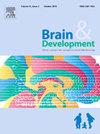Relapse in pediatric anti-N-methyl-d-aspartate receptor encephalitis: A cohort study in one of the national children's medical center in China
IF 1.3
4区 医学
Q4 CLINICAL NEUROLOGY
引用次数: 0
Abstract
Purpose
To retrospectively analyze the clinical characteristics and relapse factors of children with relapsed anti-N-methyl-d-aspartate receptor (NMDAR) encephalitis in south China.
Methods
Clinical data of children diagnosed with relapsed anti-NMDAR encephalitis in Guangzhou Women and Children's Medical Center from October 2014 to June 2022 were collected. Patients with monophasic disease course in the same follow-up period were randomly selected as controls. Statistical analysis was performed using SPSS IBM 28.0 and figures were graphed using GraphPad Prism 7.01.
Results
A total of 18 children diagnosed with relapsed anti-NMDAR encephalitis (male: female 5:13). The initial onset age was (9.8 ± 3.1) year-old. Relapse interval was 7.0 [interquartile range (IQR) 6.5–15.0] months. Compared with relapses, neurological symptoms were more extensive and mRS scores were higher at the first episode (P = 0.000 in both). Female gender was an independent risk factor for relapse [odds ratio (OR) =0.055, 95 % confidence interval (CI): 0.003–0.907, P = 0.043]. Compared to the patients with monophasic disease course, the relapsed ones were prone to leave neurological sequelae (P = 0.011) at the last follow-up.
Conclusions
Relapses often occur within 1 year after the first episode in children with anti-NMDAR encephalitis. Relapses were milder than first episodes. Female sex is an independent risk factor for relapses. The relapsed individuals were prone to leave neurological sequelae at the last follow-up.
儿童抗n -甲基-d-天冬氨酸受体脑炎复发:中国某国家儿童医学中心的队列研究
目的回顾性分析中国南方地区儿童抗n -甲基-d-天冬氨酸受体(NMDAR)脑炎复发的临床特点及复发因素。方法收集广州市妇女儿童医疗中心2014年10月至2022年6月诊断为复发性抗nmdar脑炎患儿的临床资料。随机选择病程相同的单相患者作为对照。统计学分析采用SPSS IBM 28.0软件,图表绘制采用GraphPad Prism 7.01软件。结果18例患儿诊断为复发性抗nmdar脑炎(男:女5:13)。发病年龄为(9.8±3.1)岁。复发间隔为7.0个月[四分位间距(IQR) 6.5 ~ 15.0]个月。与复发相比,首发时神经系统症状更广泛,mRS评分更高(两者P = 0.000)。女性是复发的独立危险因素[比值比(OR) =0.055, 95%可信区间(CI): 0.003 ~ 0.907, P = 0.043]。与单相病程患者相比,复发患者在末次随访时更易留下神经系统后遗症(P = 0.011)。结论抗nmdar脑炎患儿首次发病后1年内常复发。复发比首次发作轻。女性是复发的独立危险因素。复发个体易在最后随访时留下神经系统后遗症。
本文章由计算机程序翻译,如有差异,请以英文原文为准。
求助全文
约1分钟内获得全文
求助全文
来源期刊

Brain & Development
医学-临床神经学
CiteScore
3.60
自引率
0.00%
发文量
153
审稿时长
50 days
期刊介绍:
Brain and Development (ISSN 0387-7604) is the Official Journal of the Japanese Society of Child Neurology, and is aimed to promote clinical child neurology and developmental neuroscience.
The journal is devoted to publishing Review Articles, Full Length Original Papers, Case Reports and Letters to the Editor in the field of Child Neurology and related sciences. Proceedings of meetings, and professional announcements will be published at the Editor''s discretion. Letters concerning articles published in Brain and Development and other relevant issues are also welcome.
 求助内容:
求助内容: 应助结果提醒方式:
应助结果提醒方式:


